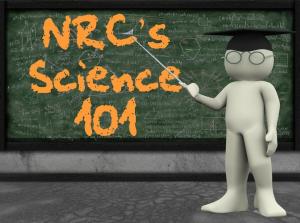 In the last Science 101 blog post, we discussed measurements made in various units of measure, particularly meters, grams and liters. You might be wondering where these units of measure come from and how they relate to one another. If so, you’re in luck, as that is the topic for today’s post.
In the last Science 101 blog post, we discussed measurements made in various units of measure, particularly meters, grams and liters. You might be wondering where these units of measure come from and how they relate to one another. If so, you’re in luck, as that is the topic for today’s post.
Quantities are characteristics or properties we are trying to measure, such as the length of an object. Units of measure are how we express measurements of quantities. For length, the unit we would use in science is meters. A unit is really only a particular amount of some quantity used as a reference point for measurements of that quantity. Put differently, units of measure are chosen and accepted by the people who use them.
Often, units of measure were agreed upon many years ago. One meter is as long as it is because that’s what scientists agreed to use as a base unit for length. A meter could have been some other length. For the sake of establishing well-defined and easily-accessible units of measure, the General Conference of Weights and Measures (a collection of scientists from multiple countries) created in 1960 the Sytème International d’Unités (otherwise known as the SI¬). This system relies upon the base units of measure listed in the following table.
Often times, however, the base unit of measure can be either too large or too small to be useful in describing a particular measurement. For example, while we could talk about the distances between cities in meters, we would be using very large (and, as such, cumbersome) numbers. For example, from Portland, Maine, to St. Louis, Missouri, is 2,060,000 m or 2,060 km. Similarly, if we are talking about the size of atoms, the basic building blocks of matter, speaking in terms of meters would be difficult as the diameter of a hydrogen atom is only 0.000000000120m. So, instead, for the sake of convenience, we often use prefixes to modify the size of the base unit. The following table lists a number of such prefixes using meter for the base.
The above table lays out conversion factors, ratios that can be used to convert one unit to another. For example, one such ratio, expressing the relationship between kilometers and meters, would be 1 km / 1000m. Using this ratio, we can convert 12348m into 12.348km (12348m x 1km / 1000m).
The NRC uses these same ideas when measuring radiation. These measurements will be discussed in an upcoming Science 101 post. As always, thank you for reading the NRC’s Science 101 blog series.




@CaptD
A little more advanced material concerning radiation exposure and dose units and instrumentation could be found in the Radiation Protection Group postings of the Nuclear Street.
http://nuclearstreet.com/radiation_protection/b/weblog/archive/2013/12/19/radiation-dose.aspx
http://nuclearstreet.com/radiation_protection/b/weblog/archive/2013/12/30/exposure.aspx
Please review both introductions and the PPT.pdf presentations, and let me know if there is something that you need more detailed information of.
The metric system of measurements has been the standard used in college science courses for over three decades. Converting between the SI units of distance is simply a matter of moving the decimal point. That is much easier and less error prone than converting between, miles, feet and inches.
Dispite various industry efforts to convert to the metric system in the US, progress is still measured in inches.
Several readers posted comments pointing out errors in the table explaining quantities and units of measure. These have been corrected, and the original comments deleted. We thank you for your keen eyes and quick responses, and we regret the errors. Moderator
Readers might like to read this PubMed article in order to see how units are used:
Lemon Balm helpful treating low dose Radiation
http://www.ncbi.nlm.nih.gov/m/pubmed/20858648/
I would like to suggest that the NRC post some charts that show amount of radiation units and how different units compare with one another. Measuring radiation with Geiger counters that all have different units only makes it more difficult for everyone to know what amounts are actually being measured and/or what levels are dangerous! This effort should be a priority since this issue is something the public needs to know about especially during nuclear power plant (NPP) radioactive releases of any kind.
Posting some Youtube videos showing common Geiger counters and how to use them would allow all users to all use the same measurement techniques and that would lead to better data for all of us.